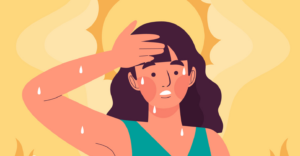Higher than usual temperatures have been recorded recently in most parts of the Philippines. Exposure to excessive temperatures for a sustained period can pose health risks ranging from relatively mild rashes and sunburn to heat stroke, a medical emergency. To prevent heat-related illnesses, make sure to take note of these important reminders.
- Monitor the heat index and follow the advice of authorities.
- Minimize time in the sun, especially during the hottest hours of the day.
- Avoid vigorous physical activity during the heatwave.
- Stay in cool air-conditioned environments if possible.
- If you must go outside, limit time outdoors, take breaks often, and wear natural fiber light-colored loose-fitting clothing, a hat, and sunglasses.
- Use an effective sunscreen.
- Drink plenty of fluids. Avoid alcohol, caffeinated, and sugary drinks.
- Rest immediately if you begin to feel weak or dizzy. Lie down in a cool, shaded place and seek prompt medical assistance if symptoms persist.
A heat index of ‘Extreme Caution’ has been recently recorded in most of the country and an index of ‘Danger’ in some areas. The National Capital Region, including Manila City, is also affected by the severe weather conditions. Exposure to these heat levels could result in fatigue, cramps and exhaustion. Prolonged exposure could lead to a heat stroke. Health officials have warned citizens to take precautions to prevent heat-related illnesses. Many schools have switched to online classes due to the hot weather.
The heat index in the Philippines is a four-tiered scale, with Caution, Extreme Caution, Danger and Extreme Danger levels. Caution is the lowest and Extreme Danger is the highest.
What are the health implications of heatwaves?
Exposure to intense temperatures can pose health risks ranging from relatively mild rashes and sunburn up to the dangerous condition heat stroke. Young children, older adults, and people with underlying health conditions are at higher risk.
Sunburn develops when skin is overexposed to ultraviolet (UV) light from the sun. The result is red, painful skin that sometimes becomes swollen and blistered. Severe sunburn can also cause chills, fever, nausea, and vomiting.
Heat rash, sometimes called ‘prickly heat’ or ‘miliaria’, often occurs on skin covered by clothing. The rash may cause no symptoms, or may itch or sting. Once in a cooler environment, it often gets better on its own. Occasionally, treatment may be required.
Heat exhaustion is a risk, especially for elderly people and those who work or exercise in hot environments. Initial symptoms are excessive sweating and muscle cramps. These can progress into fatigue, headache, dizziness, fainting, and other symptoms. The situation is more serious if dehydration symptoms develop (dry skin and mouth, increased thirst, fast pulse).
Heat stroke is a serious illness and a medical emergency. It occurs when the body’s cooling mechanism fails due to prolonged exposure to high temperatures. Body temperature rises to dangerous levels during heat stroke. This can occur quickly: temperatures may rise to 41 degrees C (106 degrees F) or even higher within 15 minutes. In addition to fever, patients may become confused, disoriented, uncoordinated, and have trouble speaking or understanding others. These are signs of serious illness. Heat stroke can cause death or permanent disability if emergency treatment is not provided.





